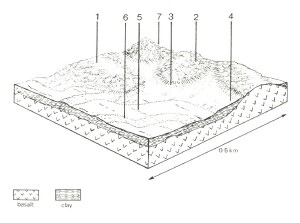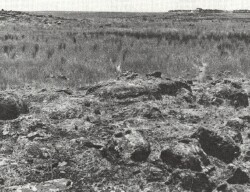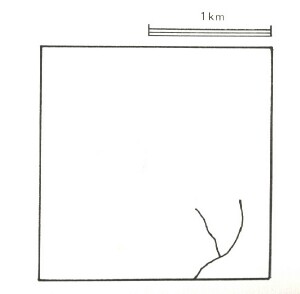Mooleric Land System
Download the pdf version of this document: Mooleric Land System (PDF - 256 KB)
To view the information, PDF requires the use of a PDF reader. This can be installed for free from the Adobe website (external link).
| The stony rises between Mount Gellibrand and the Baron River were among the first areas grazed in this part of Victoria. The stony rises are both interconnected and solitary and they slope southwards away from Mount Gellibrand. The major areas is found north of the Princes Highway, but occasional vents or old cones also occur further south. The nature of the native vegetation is difficult to determine. Many early reports describe the area as a treeless plain, but there are occasional specimens of Acacia melanoxylon, A. implexa and even Eucalyptus viminalis in roadside reserves. Thus, there may have originally been a low open woodland prior to settlement, which has disappeared following grazing and burning. Stony rise landscapes in other parts of Victoria possess woodland or low woodland communities. Soil nutrient levels are high on these basalt outcrops, especially in the less weathered soils. The abundance of rock floaters and outcrops makes cultivation difficult even on infilled swamps between the rises. Thus grazing, often on unimproved pastures, is the main land use. |  |
 Depressions between the stony rises are infilled with basaltic clay and organic clay, both of which have low permeability, leading to waterlogging. |  |
Area: 45 km2 | Component and its proportion of land system | ||||||
1 5% | 2 9% | 3 7% | 4 45% | 5 25% | 6 5% | 7 4% | |
| CLIMATE Rainfall, mm | Annual: 550 – 600, lowest January (25), highest August (60) | ||||||
| Temperature, 0oC | Annual: 13, lowest July (8), highest February (19) | ||||||
Temperature: less than 10oC (av.) June - August | |||||||
Precipitation: less than potential evapotranspiration late September – April | |||||||
| GEOLOGY Age, lithology | Pleistocene basalt, scoria and tuff | ||||||
| TOPOGRAPHY Landscape | Stony rise, undulating plain with occasional steep hills (volcanic cones) | ||||||
| Elevation, m | 120 – 250 | ||||||
| Local relief, m | 5 | ||||||
| Drainage pattern | Dendritic | ||||||
| Drainage density, km/km2 | 0.2 | ||||||
| Land form | Stony rise | Plain | Cone | ||||
| Land form element | Broad crest | Steep slopes, narrow crest | Apron | Gentle slope | Depression | Bank | - |
| Slope (and range), % | 2 (0-3) | 10 (3-15) | 5 (3-9) | 1 (0-3) | 0 (0-3) | 1 (0-2) | 10 (1-25) |
| Slope shape | Linear | Convex | Concave | Linear | Concave | Convex | Linear |
| NATIVE VEGETATION Structure | Possibly low woodland | Possibly sedgeland | Possibly low woodland | ||||
| Dominant species | Acacia melanoxylon, A. implexa, E. viminalis | Juncus spp., Ranunculus spp., Carex spp., Scirpus calocarpus, Schoenus apogon | Acacia melanoxylon, A. implexa, E. viminalis | ||||
| SOIL Parent material | Basalt | Freshly weathering rock | Colluvium, mainly clay | Basalt | Alluvium, plant remains | Basalt | Scoria, tuff, basalt |
| Description | Grey calcareous sodic duplex soils, coarse structure | Stony red-brown gradational soils | Black calcareous clay soils, uniform texture | Grey calcareous sodic duplex soils, coarse structure | Grey calcareous sodic clay soils, uniform texture | Grey calcareous sodic duplex soils, coarse structure | Stony red-brown gradational soils |
| Surface texture | Clay loam | Loam | Clay | Fine sandy loam | Clay | Fine sandy loam | Clay loam |
| Permeability | Very low | High | Very low | Very low | Very low | Very low | High |
| Depth, m | 0.2 | 0.2 | 1.2 | 1.9 | >2 | >2 | 0.9 |
| LAND USE | Cleared areas: Sheep and beef cattle grazing; some minor cropping between stony rises. | ||||||
| SOIL DETERIORATION HAZARD Critical land features, processes, forms | Soils of low permeability are prone to waterlogging. | Stony shallow soils with low water-holding capacity, over rock layers on steep slopes, are prone to sheet erosion. | Soils of low permeability are prone to water logging. | Sodic clay subsoils of low permeability with seasonally high water tables are prone to soil salting. | Soils of low permeability and with sodic clay subsoils are prone to waterlogging, soil compaction and soil salting. | Minor hazards. | Stony shallow soils with low water-holding capacity, over rock layers on steep slopes, are prone to sheet erosion. |


